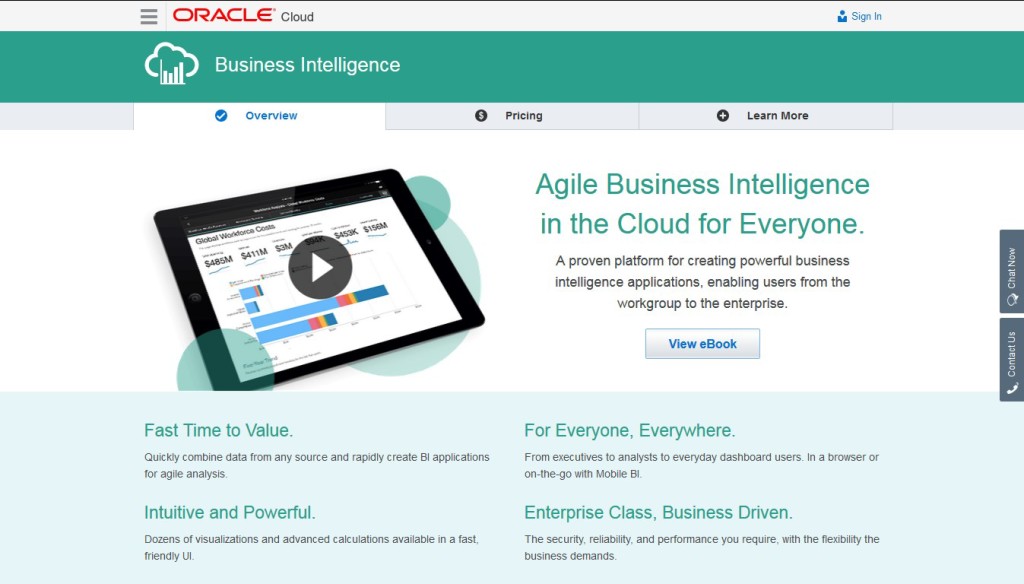01 Sep 2015 Oracle BI Cloud Service Part I: Introduction & Key Features
Last year Oracle released the Business Intelligence Cloud Service (BICS) as part of its Platform as a Service (PaaS) offering, and it has been releasing upgrades regularly since then, some with important new features. In this BICS post series we will be giving an overview of the BI cloud service and walking you through some of its key features and functions:
- Part I: Introduction & Key Features
- Part II: Loading Data
- Part III: Modeling Data
- Part IV: Creating analyses, reports and dashboards
- Part V: Managing the Service & Conclusion
Cloud technologies are not something from the future anymore but a reality, with some operating systems like Google Chrome OS relying almost completely on cloud applications. Trends indicate that the shift towards cloud environments will accelerate even more in the next years, so companies are rushing to release cloud versions of all their software solutions. Oracle has been releasing many of its software platforms into the cloud over the past years, and last year was the turn of OBI with the Business Intelligence Cloud Service.
Figure 1: Business Intelligence Cloud Service Web Page
Below are some of its key features.
The service is 100% cloud-based, with almost no local installs needed (some data loading tools might be required locally), and it comes bundled with the Oracle Database Schema Service, as BICS can only report against data stored in the cloud. With the Database Schema Service you get 1 schema on Oracle Database 11g with 50GB of storage, full PL/SQL support, multiple tools for loading the data, Oracle Exadata hardware running in the background, RESTful web services, and Oracle Application Express (APEX), but no SQL*Net access. Since the last release, there is also the possibility to connect the BI service to a Database as a Service (DBaaS), which includes a dedicated virtual machine running Oracle Database 11g or 12c with full SQL*Net access and all the storage capacity we may need. One of the most interesting features of the service is that it is 100% mobile ready: all the content you create in the cloud will be immediately available in any iOS or Android device downloading the Oracle BI Mobile App from the App Store or Google Play and with no extra programming required (touch gestures such as zoom or swipe are already built in).
Figure2: 100% mobile ready.
(From the Oracle BI Cloud Service & Data Discovery Webinar from Oracle Deutschland B.V. & Co. KG)
The service comes with two instances: PROD and pre-PROD for developing and testing, and provides automatic full system backup & restore, role based grain security, and simple self-administration. All the patching and system maintenance is handled by Oracle so you don’t have to worry. So what are the benefits of the BI Cloud Service compared to the traditional on-premise OBI? The first benefit we can think of is the huge cost reduction: you only have to pay a monthly subscription of $250 per month and per named user (10 users minimum) for the BI Cloud Service plus $1000 per month for the 50GB of cloud storage in the Database Schema Service, so a minimum of $3500 per month, which is much cheaper than an OBIEE license.
Not having to purchase annual licenses and being able to pay just for the storage capacity you require are big bonuses too. Moreover, working in the cloud means working with a standardised and consolidated infrastructure (there is no need for servers, storage, or any other network components). Therefore, you get to dramatically reduce your capital and operation expenditures compared to the expenditures you would incur with on-premises OBI. As you need fewer database elements and you get standardised operating systems, servers, database versions and configurations, the administrative burden is also dramatically reduced. Also given that the system maintenance is fully managed by Oracle, you get guaranteed system availability. This means that overall the environment will be more reliable and manageable, resulting in lower risks for the user.
Finally, another key benefit of using the BI Cloud Service is agility. The rapid deployment of environments for development and production and the shorter upgrade cycle make the system highly agile, and thanks to the Oracle Real Application Clusters (RAC) you get adaptive cloud databases for workload volumes. Be sure to check out the rest of our BICS series posts for more detailed information on the basic features of the service.



